Sports Equipment Warranties:
Everything from StairMasters to snowmobiles carries product warranties, and cost their manufacturers a significant amount of money for warranty work. But compared to the billions spent by GM, HP and others, it's easy to overlook their corner of the warranty industry.
Sports equipment comes in many shapes and sizes, cutting across industries as diverse as electronics, automotive, and apparel. Sports equipment warranties, despite their being only a tiny fraction of the billions spent on claims within these industries, are a major expense for some of the individual companies.
Among the thousand or so companies tracked by Warranty Week, roughly 32 current and 13 former companies manufacture and warrant products that would fit under the "sports equipment" heading. The problem is that they seem to fit better under other headings, such as Microsoft's Xbox line (consumer electronics) or Jarden's Coleman gear (appliances).
So while we can report that "sports equipment" manufacturers have paid roughly $850 million in claims so far this year -- and that's up from $700 million in the first nine months of 2007 -- we're afraid that most of it has been already counted in other categories. For instance, take Microsoft, Jarden and Harley-Davidson off the list and claims for the remaining "sports equipment" companies are down to only $280 million this year.
Fortunately, many of the remaining companies have no other industry to which they could potentially belong. Where else to put weightlifting machines, golf clubs, or camping gear than under the "sports" heading? And while one could debate the merits of including guns and games under such a heading, where else could one put baseball or hockey gear?
What we propose to do in this week's newsletter is to take a first-time look at some of these sports equipment vendors, with the first three companies clearly in the industry, the fourth somewhat in the industry, and the fifth (Harley) only peripherally in the industry (although the company readily admits that most of its customers are buying luxury vehicles for fun and recreation more so than for mere transportation).
Golf Clubs
Let's start with a pair of snapshots for Callaway Golf Co., a prominent golf club maker which was the subject of a Warranty Week article way back on March 24, 2003. At that time, the company had just fired its auditors at KPMG LLP because they refused to go along with the accounting treatment the company preferred to use to report a downward change in its warranty cost estimates.
Back in 2002, Callaway had noticed that claims on a new line of titanium clubs were being paid at a lower rate than it had initially predicted, and so it wanted to take $17 million out of its warranty reserve, pay taxes on it, and report a one-time $10.5 million net boost to profits. KPMG insisted that the excess $17 million be treated as a cumulative error, and that its removal should be reported retroactively, spreading the earnings boost over multiple quarters.
To make a long story short, KPMG got the boot, Callaway got its boost, and Deloitte & Touche LLP got its foot in the door as the company's new auditors. The downward change in estimate resulted in a one-time gain that helped the company avoid back-to-back quarterly losses, but of course that was a secondary effect of the increased product quality that caused it.
None of that controversy is visible in either Figures 1 or 2, but perhaps that's the point? The company got its way, lowered its warranty costs, and business continued as usual. Callaway continued making golf clubs, and continued to pay claims. There was no long-lasting effect, and no shortfall that later needed to be corrected.
However, now that we have five more years of data, it becomes immediately apparent that Callaway could use a few lessons in how to manage warranty costs for such a seasonal product line as golf clubs. Claims always spike in the third quarter and plunge in the first quarter, which of course meshes well with the golf season in its major markets. But they average out over the course of the year to somewhere within the 1.5% to 1.8% range.
If that's the case, the company should be accruing funds at more or less the same rate in every season, flattening out the green line in Figure 1, as many of the farm equipment and homebuilding companies have learned to do. But instead, accruals rise and fall in much the same seasonal pattern as claims, rising as high as 2.4% of sales and plunging as low as 0.9%.
Figure 1
Callaway Golf Co.
Warranty Claims & Accrual Rates, 2003-2008
(in $ Mil & percentage of product sales)
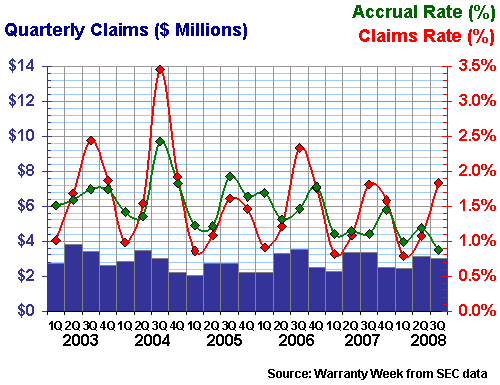
Interestingly, the low mark for accruals was set just this past summer, meaning there is now almost a full percentage point of difference between the claims and accrual rates in the most recent quarter. Though the gap has been wider in the past, such a divergence has never before happened when claims jumped and accruals dove. Usually, they rise and fall together, especially in the peak season.
Another Quality Boost?
The company said it recently cut back on accruals because of "the improved durability of newer products," which means it expects to pay out less claims in the future, and has reduced the amount it sets aside accordingly. That trend is yet to be reflected in the current claims data, but as was the case back in 2003, let's give the company the benefit of the doubt and see what the next few quarters look like.
The 2002 controversy was about fixing past estimates that turned out to be too high, by removing $17 million from the warranty reserve. And that doesn't really show up in Figure 2, because the data doesn't begin until 2003. And since then, the company has kept its warranty reserve within a relatively narrow range of $12 to $15 million. However, because claims are fluctuating so wildly from one season to the next, that volatility spills over into the capacity index, as illustrated by the dark blue line below.
Figure 2
Callaway Golf Co.
Warranty Reserves & Capacity, 2003-2008
(in $ Mil & number of months of claims payable)
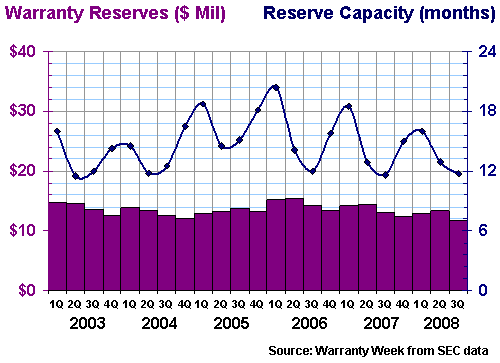
The capacity index takes the amount paid per month in claims and divides it into the warranty reserve balance. If Callaway were paying out $1 million per month in claims and had a warranty reserve balance of $12 million, the fund's capacity would be equal to 12 months. But if claims dropped to $667,000 per month, the capacity would jump to 18 months. And indeed, that's what's happening in Figure 2, as summer turns to winter and back to summer again.
By the way, Callaway's golf club warranties last 24 months, and it makes a point to note that in the name of customer service it frequently honors claims even after that two-year period has expired. As can be seen in Figure 2, however, the company's capacity to pay claims has not once hit 24 months during the past six years.
Exercise Equipment
Next, let's look at a pair of exercise equipment manufacturers that are less seasonal but just as volatile in their warranty cost accounting. Nautilus Inc. is the manufacturer of fitness and exercise equipment sold to consumers under brand names such as Nautilus, Bowflex, Schwinn Fitness, and StairMaster. It also sold TreadClimber exercise equipment into the commercial market, but discontinued doing so earlier this year when warranty claims rose to unacceptable levels.
In Figure 3, it's clear when those levels became unacceptable. In the fourth quarter of 2007, accruals spiked to 5.4% of product revenue, and six months later claims jumped above 5% of revenue for the first time. The claims rate has now dropped back down to 4%, but it's still higher than it's been at any point during the previous five years.
Figure 3
Nautilus Inc.
Warranty Claims & Accrual Rates, 2003-2008
(in $ Mil & percentage of product sales)
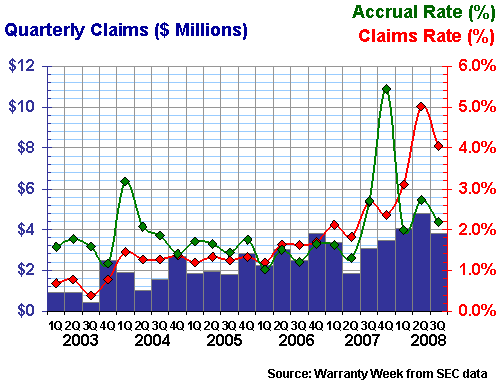
The TreadClimber problem has also made itself visible in the company's warranty reserve balance, charted below in Figure 4. When that crisis hit at the end of 2007, Nautilus tripled its warranty reserve balance from $8.4 million as of September 2007 to $25.2 million at the end of that year. It's since fallen gradually back down to $19.8 million by September 2008, but that's still more than twice as much as was in the reserve a year before.
Figure 4
Nautilus Inc.
Warranty Reserves & Capacity, 2003-2008
(in $ Mil & number of months of claims payable)
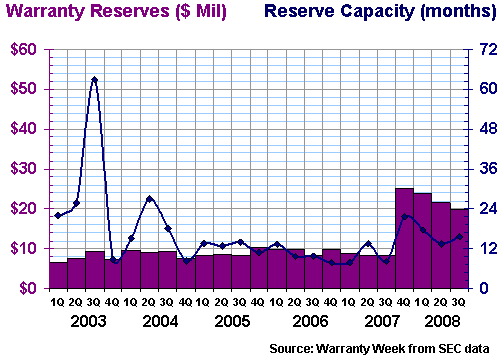
The capacity to pay claims has also soared, from 8.1 months in September 2007 to 15.6 months in September 2008, but remember that claims paid per month as well as the reserve balance have also soared during the period. Still, for three years before the TreadClimber problem hit, the reserve's capacity was always kept between 8 and 14 months.
Commercial Customers
Nautilus competes with our next profiled company, Cybex International, though the latter is more focused on the commercial market for exercise and weightlifting equipment. The roster of Cybex brand names includes Stableflex, Arc Trainer, Cyclone, Home Arc, Legacy, Safety Sentry, Total Body Arc Trainer, and Trotter Elite, among others.
As can be seen in Figure 5, Cybex is well-accustomed to paying out 2% to 3% of product revenue to satisfy warranty claims, while as can be seen in Figure 3, Nautilus reached these levels only in the past year. And of course Nautilus blamed that rise on unacceptably high claims rates in its commercial product line.
So let's go out on a limb here and suggest that perhaps 2% to 3% is normal for the commercial market. Perhaps consumers are more likely to just give up and push the equipment under the bed or use it as a clothes hanger. This is unacceptable in the commercial market, where the customers of health clubs, hotel spas, and gyms expect every piece of equipment to be working every time they visit.
Figure 5
Cybex International Inc.
Warranty Claims & Accrual Rates, 2003-2008
(in $ Mil & percentage of product sales)
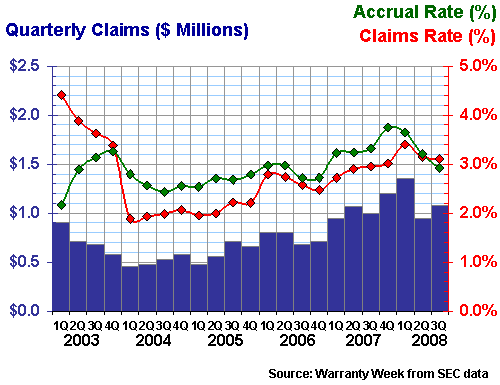
Cybex saw a near-term peak in its claims rate of 3.4% in the first quarter of 2008. It has since fallen back to 3.1%. Meanwhile, as can be seen in Figure 6, its warranty reserve balance peaked at $4.4 million in the second quarter of this year, and has fallen back since.
Reserve capacity has fluctuated from 9.5 to 15 months over the years, but the average has always remained very close to 12 months. Although the structural frames of some of its exercise equipment models carry warranties of up to ten years, many of the moving parts are warranted for only one year and labor is covered for three years at most.
Figure 6
Cybex International Inc.
Warranty Reserves & Capacity, 2003-2008
(in $ Mil & number of months of claims payable)
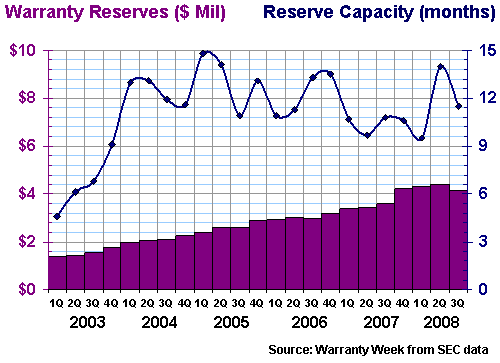
Footwear Warranties
Now let's shift the focus away from equipment and into apparel. Clothing, for the most part, is not usually covered by an express product warranty, although of course it must adhere to certain implied warranties of merchantability and fitness for a particular purpose. Our next company snapshot is for a company that's an exception to that rule.
LaCrosse Footwear sells specialty footwear to customers such as firefighters, police forces, construction workers, loggers, soldiers, shipyard workers, and farmers. It gets its name from its former home town of LaCrosse, Wisconsin, where it was founded in 1897, producing leather and rubber boots favored by those who work in a cold or wet outdoor setting.
Simply put, these are not tennis shoes or casual slippers. These are high-performance products more akin to welding helmets or Kevlar vests, designed to shield their wearer from a harsh environment. They're in our sports equipment roundup simply because some of the company's products are sold by sporting goods retailers, and some of its customers are hunters, fishermen and others whose hobbies rather than their vocations make them stand outside for long periods of time.
As is evident in Figure 7, the protective footwear business is highly seasonal, with the bulk of sales (and warranty claims) coming in the cold half of the year. And we could level the same criticism at LaCrosse as we did at Callaway: sure, claims are seasonal, but why not flatten out accruals to a constant 1.6% or 1.8% of sales over the course of the whole year?
Figure 7
LaCrosse Footwear Inc.
Warranty Claims & Accrual Rates, 2003-2008
(in $ Mil & percentage of product sales)
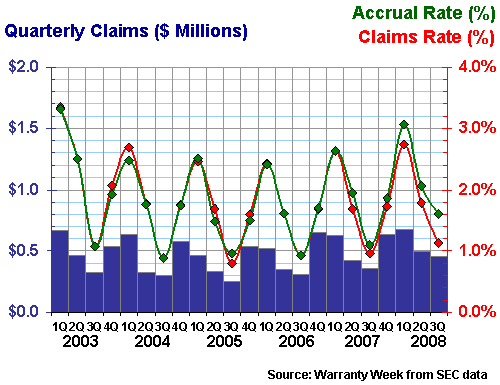
It's much the same story with LaCrosse's warranty reserves. The balance has remained close to $1 million over the past six years, but because of the 180-day cycle in the claims rate, its capacity has oscillated from 4 to 11 months. If claims were to somehow flatten out, the capacity line in Figure 8 would also flatten out at around six months of coverage.
Figure 8
LaCrosse Footwear Inc.
Warranty Reserves & Capacity, 2003-2008
(in $ Mil & number of months of claims payable)
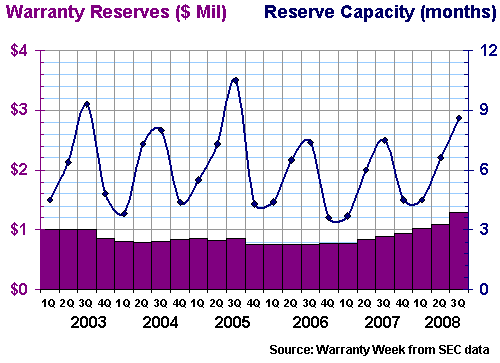
Sports Vehicles?
Finally, we concentrated so much on passenger cars and bailouts in our November 13 newsletter on automotive OEMs that we never once mentioned some of the sports vehicle manufacturers. Sure, we provided snapshots for one of the recreational vehicle companies, but there was no mention of specialized vehicle makers such as Arctic Cat Inc., Polaris Industries Inc., or our next profiled company, Harley-Davidson Inc.
For the record, claims at Polaris are up slightly while accruals are down significantly, while its warranty reserve is shrinking despite increasing sales. At Arctic Cat, claims, accruals, and warranty reserves are down slightly while sales are up slightly. But as we've detailed in newsletters such as the September 12, 2008 issue, the warranty data for these companies in particular is highly seasonal, so perhaps the end of summer isn't the best time to evaluate their warranty costs.
The one we haven't profiled since October 17, 2006 is Harley-Davidson -- frankly because the company so consistently and so predictably turned in warranty claims and accrual rates under one percent in an industry where 2% or even 3% was more the norm. But then in 2007 the claims rate twice hit 1.3%, and then in the most recent quarter, rose above 1.6%. As can be seen in Figure 9, it hasn't been higher since at least 2003.
Figure 9
Harley-Davidson Inc.
Warranty Claims & Accrual Rates, 2003-2008
(in $ Mil & percentage of product sales)
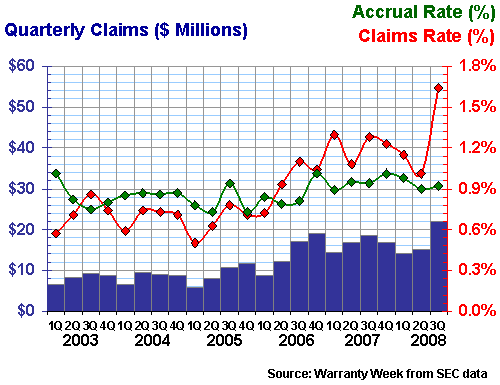
Notice that while claims rose, accruals remained below one percent of sales. It's as if the company is saying "What quality problem? We don't see any quality problem. We're not adjusting accruals upward." And as a direct result, the warranty reserve is beginning to shrink, and the coverage it provides has fallen below 12 months (on vehicles that are warranted for two years).
Figure 10
Harley-Davidson Inc.
Warranty Reserves & Capacity, 2003-2008
(in $ Mil & number of months of claims payable)
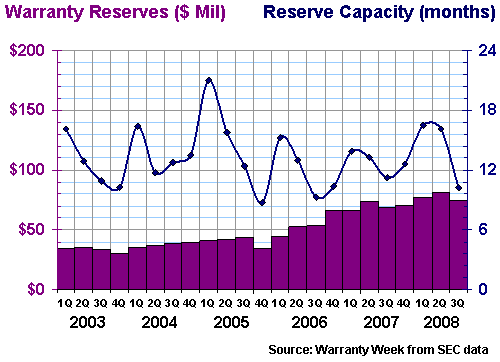
Harley's motorcycle sales revenue is also down about 1.6% for the year so far, which may explain some of the rise in claims, since the company is effectively fixing last year's bikes with this year's money. And yes, the company lengthened its warranties from one year to two beginning with the 2004 model year, and yes, that second year has cost it some extra money ever since. But while accruals in 2004 averaged 0.8% of motorcycle sales, they averaged only 0.95% in 2007 and 2008. That's not much of an upward trend. Meanwhile, claims haven't been below 1.0% of sales since 2006.
It's clear from Figure 9 that claims and accrual rates began to diverge in 2006. And it's clear from Figure 10 that the warranty reserve's capacity to pay claims has fallen in the most recent quarter and hasn't grown in the past four years despite the increased need for funds that lengthening warranty durations would seem to require. Neither trend is that ominous, and both are dwarfed by the twin impacts of tightened credit and lower sales, but some corrective action is needed in the warranty department.









